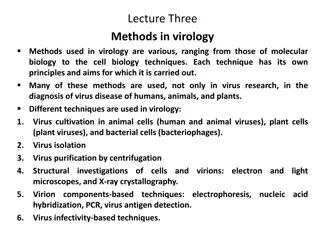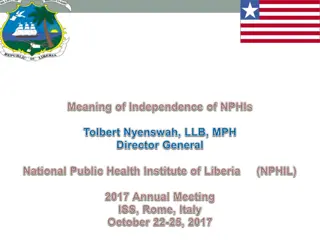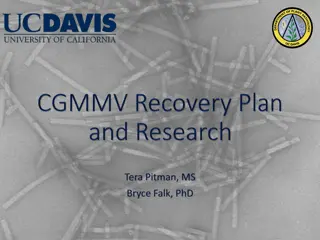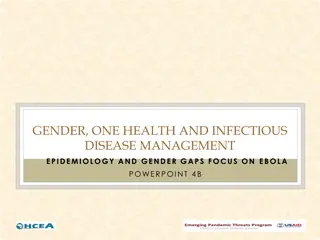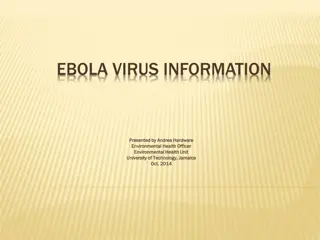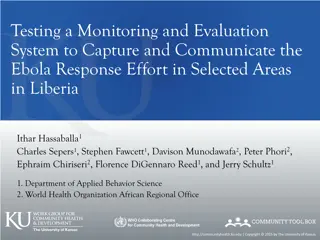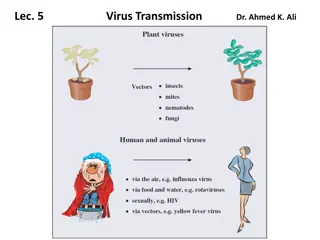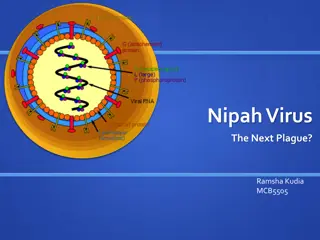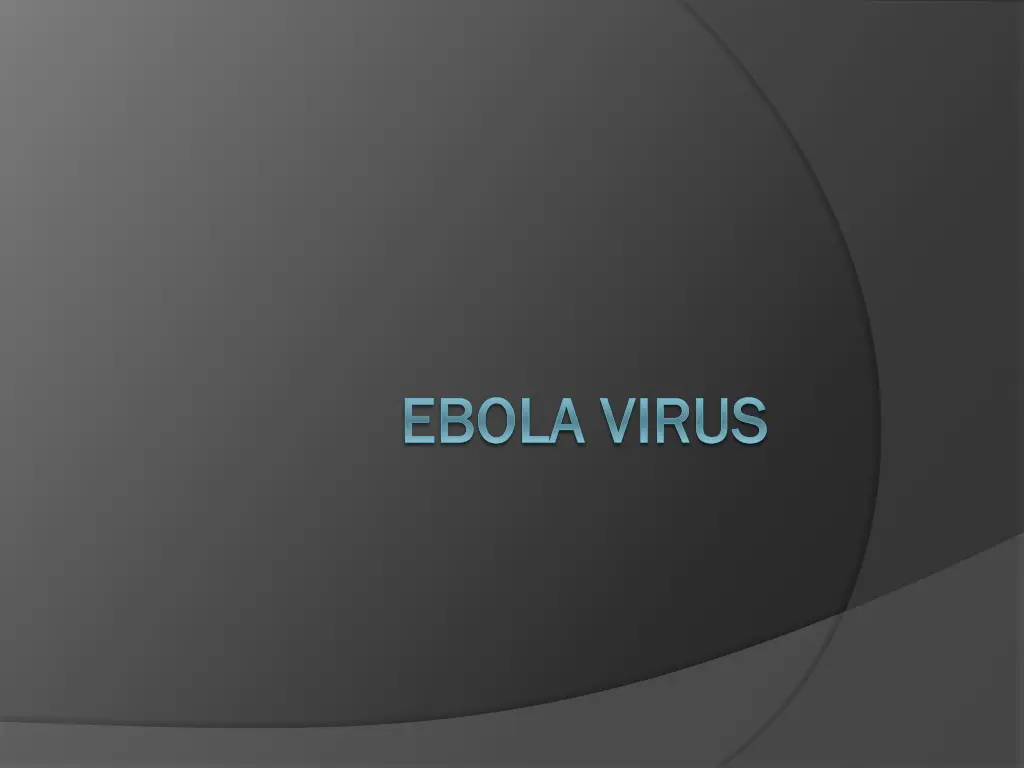
Understanding Ebola Virus: Types, Outbreaks, Symptoms, and Treatment
Explore the different types of Ebola virus, its history of outbreaks, mode of transmission, symptoms, diagnosis, and treatment options. Learn about the deadliest Ebola outbreaks, including the devastating impact on West Africa in 2014. Discover how this infectious disease spreads and how to control its transmission.
Download Presentation

Please find below an Image/Link to download the presentation.
The content on the website is provided AS IS for your information and personal use only. It may not be sold, licensed, or shared on other websites without obtaining consent from the author. If you encounter any issues during the download, it is possible that the publisher has removed the file from their server.
You are allowed to download the files provided on this website for personal or commercial use, subject to the condition that they are used lawfully. All files are the property of their respective owners.
The content on the website is provided AS IS for your information and personal use only. It may not be sold, licensed, or shared on other websites without obtaining consent from the author.
E N D
Presentation Transcript
EBOLA VIRUS EBOLA VIRUS
CONTENTS Introduction Types of Ebola Virus Outbreak of Ebola Virus Structure Classification Ebola Virus Disease Mode of Transmission Mechanism of action Symptoms Diagnosis Treatment Controlling the spread of Ebola Conclusion
INTRODUCTION Ebola is negative RNA virus. Ebola Virus is responsible for viral hemorrhagic fever like :- Lassa fever, Yellow fever, Marburg fever, Dengue fever.
Ebola virus is called as hemorrhagic because bleeding will occur during the course of illness. Ebola virus can cause bleeding inside and outside the body Ebola strikes mainly in villages of central and west Africa but it has also spread to African cities too.
Ebola virus is an infectious which kill in a short time. Needs a host cell to survive. Considered like a non-living entity. Which is a severe, often-fatal disease caused by infection with a species of Ebola virus
TYPES OF EBOLA VIRUS EBOLA VIRUS (ZAIRE EBOLAVIRUS) SUDAN VIRUS (SUDAN EBOLAVIRUS) TA FOREST VIRUS (TA FOREST EBOLAVIRUS) BUNDIBUGYO VIRUS (BUNDIBUGYO EBOLAVIRUS) RESTON VIRUS (RESTON EBOLAVIRUS)
OUTBREAK OF EBOLA VIRUS First appeared in 1976 at Nzara in Sudan and at Yambuku in the democratic republic of Congo near Ebola river in Africa Second appeared in Africa 1989 in Reston Third appeared in 2014 West Africa affecting Guinea, Sierra, Leone, Liberia and Nigeria
STROKES YEAR REGION AFFETCTED DESCRIPTION FIRST 1976 Democratic republic of Congo (ZAIRE) & Sudan First outbreak of Ebola. Haemorrhagic fever SECOND 1989 RESTON, VIRGINIA Mysterious outbreak. (initially diagnosed as Simian haemorrhagic fever virus (SHFV) among a shipment of crab eating macaque monkeys imported from the Philippines. Named Reston ebolavirus (REBOV) THIRD 2014 WEST AFRICA - affecting Guinea, Sierra Leone, Liberia and Nigeria. Largest outbreak to the date
STRUCTURE Genome 19kb long. Diameter 80nm; length 960nm to 1200nm. Four viral proteins: polymerase (L), nucleoprotein, and proteins VP35 and VP30. Spikes formed by GP1/GP2 Complexes (envelope glycoprotein). VP24 (membrane protein) associated with envelope.
CLASSIFICATION Order : Mononegavirales Enveloped, nonsegment, negative strand RNA viruses. Family : Filoviridae, contains 3 genera : Ebola virus (1976) Marburg virus Cueva virus Genus : Ebola virus, named after the Ebola river where it was first found.
Ebola Virus Disease Ebola virus disease (formally known as Ebola haemorrhagic fever )is a disease caused by the Ebola virus in severe fatality rate, 90% affects human and non human primates.
MODE OF TRANSMISSIOM Unsterilized needles. Sub optical hospital conditions. Personal contact. Through blood to blood contact. Human to human transmission. Reusing needles and blood gloves in hospital.
MECHANISM OF ACTION : Every tissue are affected, except bones and muscles. The virus creates blood clots. Clots goes towards internal organs (lungs, Eyeball). It prevents oxygen to rise tissue. The virus also destroys connective tissue (affinity with collagen).
SYMPTOMS INTIAL SYMPTOMS High temperature (at least 38.8c) Muscle, joints, abdominal pain Nausea Blood stream slow down Loss of appetite Rashes Increased liver enzyme activity
LATE SYMPTOMS Vomiting Diarrhoea Coughing Pharyngitis Prostration Severe Vomiting Blood Haemorrhage Internal and external haemorrhages from orifices (nose, mouth, skin, eyes). Low white blood cell count
Diagnosis Diagnosing Ebola can be difficult at first since early symptoms, such as fever, are nonspecific to Ebola infection.
Samples from the patient can then be collected and tested to confirm infection are: Antibody-capture enzyme-linked immunosorbent assay (ELISA). Antigen-capture detection tests. Serum neutralization test. Reverse transcriptase polymerase Chain reaction (RT-PCR) assay. Electron microscopy. Virus isolation by cell culture.
TREATMENT There are no licensed specific treatment. Patients are Frequently dehydrated and requires oral Rehydration with solution containing electrolyte. New drug therapies are being evaluated. However there have been very recent development in preventative medication.
Recommend care includes:- Volume repletion Maintenance of blood pressure (with vasopressors if needed) Maintenance of oxygenation Pain control Nutritional support Treating secondary bacterial infections and pre-existing comorbidities
CONTROLLING THE SPREAD OF EBOLA Hospitals must follow precautionary methods, such as: Wearing gloves. Isolating infected individuals. Practicing nurse barrier techniques. Proper sterilization and disposal of all equipment. Burials must be done correctly: No washing or touching carcass. Put into body bags and bury outside city. Report any questionable illness to officials.
CONCLUSION Ebola virus is extremely virulent. The infected organism does not have time to react to the virus. First symptoms appear during the critical period. Even though scientists have recently made breakthroughs there is still need for extensive research to find vaccines and cures for this deadly virus.





